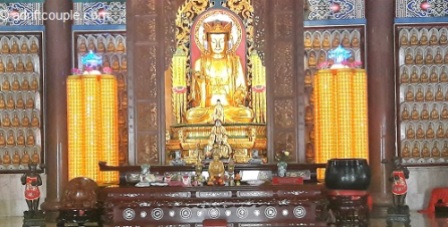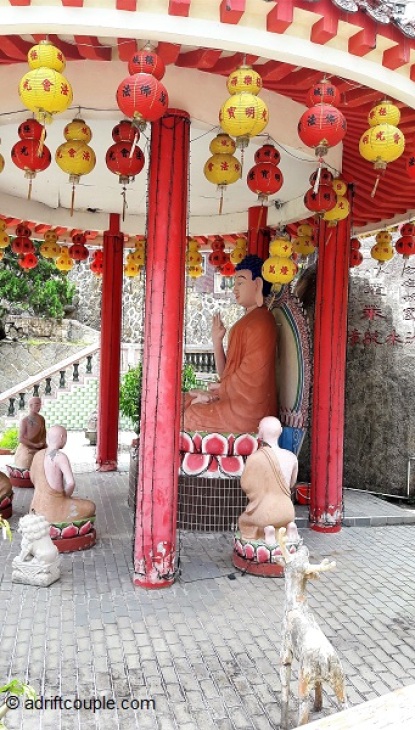PENANG, George Town – A Captivating Microcosm!

 Molly, the enthusiastic guide at the Cornwallis Fort (established in 1786 by Francis Light of the British East India Company) regaled us with folklore and engrossed us in its history. It was an afternoon well spent at The Fort which prominently dominates George Town (a Unesco World Heritage Site), the colonial part of Penang island and the capital city of the Malaysian state.
Molly, the enthusiastic guide at the Cornwallis Fort (established in 1786 by Francis Light of the British East India Company) regaled us with folklore and engrossed us in its history. It was an afternoon well spent at The Fort which prominently dominates George Town (a Unesco World Heritage Site), the colonial part of Penang island and the capital city of the Malaysian state.

Chew Jetty, a Unesco World Heritage Site, established in the mid 19th century, comprises of 75 dwelling units. The original ancestors were from Xinglinshe Village of Fujian province in China. It is rather bizarre that people still live this way!
However besides British Georgian and Neo-Georgian buildings, the city has a great influence of Chinese civilization and architecture established by rich traders and working class squatters in late 19th and early 20th centuries in the form of Clan Houses and Clan Jetties besides the Kek Lok Si Temple – a blend of Buddhist teachings and Chinese culture.
 We went around exploring these and other enthralling sites over the next two days.
We went around exploring these and other enthralling sites over the next two days.
Fortunately for us we chanced upon, just outside our hotel, Shukriya, a local cabbie, who we hired exclusively to take us around the city and its suburbs. He was an unpretentious and affable soul, eager to please and contributed to a delightful and pleasant experience in the island city.

Wat Chaiyamangalaram Thai Buddhist Temple.
Other Asian architectural styles were present in the beautiful Burmese and Thai Buddhist temples. The finest spectacle of the city and the seascape are from Penang Hill which is accessible by a 2 km long funicular railway having been built by the Britishers in 1923.
For us a very captivating part of our visit to this microcosmic place was the enchanting street art in the Chulia and Armenian Streets. With real props like a chair and a motorcycle, the murals in the bylanes looked amazingly lifelike, many having been created by Lithuanian artist, Ernest Zacharevic.
Though, in the evening, we did go to Batu Ferringhi, the beach stretch with its flea market and seafood restaurants, the highlight of our Penang sojourn were its fascinating classical structures steeped in history.
Bars and pubs with intriguing names such as Slippery Senoritas notwithstanding, the nightlife in George Town was staid both at the Strip and Gurney Drive. We were told it was so because of non tourist season and the days we were there not being a weekend.
It was a fabulous couple of days break spent at Penang, glad that we chose to stay at George Town, during our two-week tour of Western Malaysia.
 Before we flew to Langkawi, Penang was the last stop of our three day, 400 kms road trip which started at Kuala Lumpur and took us through Kampar (the original tin mining town), Gua Tempurung (one of the longest caves in Malaysia with spectacular stalactites and stalagmites), Kellie’s Castle (a haunted mansion with Scottish, Moorish & Indian architecture), Kek Lok Tong Cave Temple (a pristine limestone cave temple with beautiful zen gardens), Ipoh (with its 1908 Concubine Lane and The Heritage Trail through the Old Town) and Taiping Lake Garden and Taiping Zoo. Having been to the zoo (realized once again that we feel sad seeing wild animals in cages and restricted areas besides a missing thrill of not seeing them in their natural habitat) we gave Bukit Merah with its Orangutan Island a miss though we had included it in our original itinerary.
Before we flew to Langkawi, Penang was the last stop of our three day, 400 kms road trip which started at Kuala Lumpur and took us through Kampar (the original tin mining town), Gua Tempurung (one of the longest caves in Malaysia with spectacular stalactites and stalagmites), Kellie’s Castle (a haunted mansion with Scottish, Moorish & Indian architecture), Kek Lok Tong Cave Temple (a pristine limestone cave temple with beautiful zen gardens), Ipoh (with its 1908 Concubine Lane and The Heritage Trail through the Old Town) and Taiping Lake Garden and Taiping Zoo. Having been to the zoo (realized once again that we feel sad seeing wild animals in cages and restricted areas besides a missing thrill of not seeing them in their natural habitat) we gave Bukit Merah with its Orangutan Island a miss though we had included it in our original itinerary.
Some Vivid Images Of Our Penang Experience – An Attempt To Capture Its Diverse Culture!
Kek Lok Si Temple

Kek Lok Si, supposedly the largest Buddhist Temple in South East Asia situated in Ayer Itam on the outskirts of George Town, is certainly the most popular landmark in Penang. It comprises of a number of buildings, prayer halls, pagodas with intricate carvings and sculptures. The first Hall of Bodhisattvas was built in 1891.

The Kek Lok Si Temple houses innumerable images of the Golden Buddha.

The Pagoda of Ten Thousand Buddhas as it is famously known, embodying as many statues in white and golden colour.
This is the striking seven-storey Rama Pagoda, completed in 1930, the foundation having been laid by King Rama VI of Thailand.
The architectural style of this Pagoda is rather unique – an amalgamation of Chinese, Thai and Burmese with the bottom octagonal base being of Chinese design, middle floors Thai styled and the top golden part being of Burmese influence.
This is a tribute towards the sponsors from the three countries.
We climbed to the top of the pagoda via a steep flight of stairs and were rewarded with a spectacular view of Penang.
The Garden Pavilion of Lord Buddha and The Five Bhikkus
This is based on the Deer Park at Sarnath (Near Varanasi, India), where The Buddha delivered his first sermon on The Middle Path to five ascetics – Kondanna, Bhaddiya, Vappa, Mahanama and Assaji and established the order of monks.
Street Art
Graffiti depicting scenes from daily life and then names scratched on monument walls exist from ancient times. “Graffiti” is from the Italian word graffiato meaning “scratched”. The origins of contemporary Urban Art lie in the political and cultural revolutions of the late 1960s and early 1970s when modern graffiti culture first found its roots. However Street Art is either conveying a message or just artistic expression and today is often sanctioned for beautification.
The bylanes of Penang are famous for Street Art Murals particularly in the Armenian and Chulia Streets and we were thrilled to see these up close.
Many have been designed by London trained, Lithuanian artist, Ernest Zacharevic, executed for the George Town Festival in 2012, catalysing the entire Penang street art movement. These images portray flashes of everyday Malaysian life and have used the locals as models.
“We actually had a chance meeting with the rickshaw puller depicted in the main picture at the top of this page!”

The most popular mural of “Little Children on a Bicycle”, on the wall of a house in the Armenian Street. The bicycle is fixed to the wall and the complete ensemble has been created by Zacharevic. The Kids on a Bike, quintessential of George Town, has become one of its most recognized icons, showcased on t-shirts and bags at souvenir shops. We were quite thrilled to pick up such a bag at the Chew Jetty.

Boy On A Motorcycle by Ernest Zacharevic – street art mural, a combination of installation and painting. You can find this popular artwork close to the Jalan Pantai Junction along Ah Quee Street. Hitch a ride and hang on tight!

The “I Want Bao” mural graces the front of the Ming Xiang Tai Pastry Shop. The artist, WK Setor, apparently, used the shop owner’s children as models and we added a third real life one! This artwork celebrates old world hawkers with their bike and bao basket. Be prepared to wait in queue if you want to get yourself photographed with the kids.


Above, to the left is the Kitty mural that shows a cat winking and hanging from a tyre!
To the right is “Reaching Up Mural” on Cannon Street. The child appears to be standing on a chair and inching himself as high as he could reach.
The above showcase but just a few of the innumerable interactive fragments of creativity in the alleys and byroads of this quaint town.
Leong San Tong Khoo Kongsi
 The Chinese immigrants had established clan houses in Penang, and we visited Leong San Tong Khoo Kongsi popularly known as just Khoo Kongsi – Khoo being the clan name and Kongsi meaning family house.
The Chinese immigrants had established clan houses in Penang, and we visited Leong San Tong Khoo Kongsi popularly known as just Khoo Kongsi – Khoo being the clan name and Kongsi meaning family house.
It is located in Cannon Square in the heart of the oldest part of the city of George Town, in the midst of narrow, winding lanes and quaint-looking pre-War houses exuding a visible old world charm.
The others in Penang are Lim, Cheah, Yeoh and Tan Kongsi. The Khoo Kongsi clanhouse has Indo-Malay influence as well and the architecture is overwhelmingly intricate and ornate. This was one of the locations for the shooting of the movie Anna & the King (1999 by 20th Century Fox).
If you have never visited a Chinese Clan House this is a great one to start with!

Originally built in 1851 and struck down by lightening in 1901, a scaled-down version was later built in 1902 and completed in 1906. Even now, the complex boasts a magnificent hall embellished with intricate carvings and richly ornamented beams of the finest wood. The architecture reflects the style of an early local bungalow and of temples in Southern Fujian with a prayer pavilion. A pair of giant green stone lions guard the courtyard of the temple and clan house.
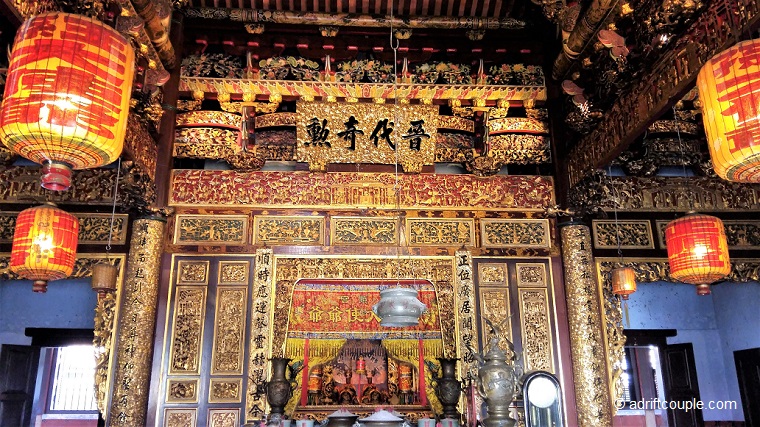
The central hall is the largest and most ornate. The walls and ceilings are covered with decorations. The clan temple is dedicated to the patron saints of the Khoo family who were mortal warriors elevated to God status after having defended China from northern invaders. It is the grandest clan temple in Malaysia and also one of the city’s major historic attractions.
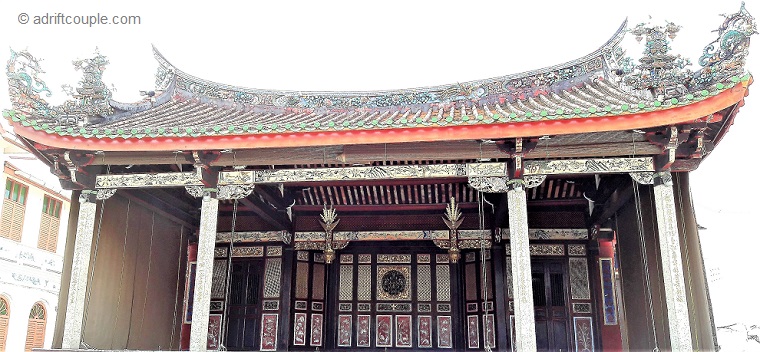
The opera stage, which directly faces the main building, was once an area used for stage performances and other entertainment. The screen wall of the front stage, which serves as the backdrop, has very rich wooden carvings and is decorated with bass-reliefs of plants, birds and animals. It is now used for festivities.
The roof of the opera stage is ornamented with Jian Nian (cut and paste) porcelain shardwork. To make a Jian Nian sculpture, the craftsman uses a pair of pliers to cut and paste the porcelain onto a stucco framework. This type of sculpture is both colorful and dazzling. It also features intricate ceramic figurines.
The most exquisite stone carvings of Khoo Kongsi are found at the verandah of the upper floor of the main hall. Each of the four very attractive octagonal column is made of a single piece of green stone, on which is carved a powerful coiled dragon.
At the entrance, we were surprised to find the statues of a pair of Sikh watchmen of Indian origin showing Asia had become multi-cultural, people travelling across the seas for work and trade. Though we wondered why the figures were stunted.

The whole surface of the front walls of the main prayer hall, from the top to bottom, is formed by a hundred spectacular panels of stone carvings. Of these, the ventilated window panels are the most exquisite. The one above is the round stone window at the verandah, featuring the “Castle of the Guan Family”.
Note: The above pictures are clicked by us and part of the explanations have been taken from Khoo Kongsi literature to maintain authenticity.
Seh Tek Kong Cheah Kongsi

Cheah Kongsi is the first of Penang’s five great Hokkien clan houses. We reached here in the evening but unfortunately for us the main gate was shut so we could only steal the above view. Surely would have loved to explore this clan house in its entirety. Located near Khoo Kongsi, it resembles the grand temples and palaces usually seen in China. We later learned that this is the only clan house in Penang that fuses Malay, traditional Straits Chinese and European designs. The sudden sight of this magnificent building made us stop in our steps. Within the grandiose of the outer structure, what mesmerized us were the columns topped with British-style ‘lion head’ statues that support a large balcony with intricate iron railings and the sweeping roof topped with exquisite Chinese and Dutch porcelain and stucco carvings of dogs and lions.
The Owl Shop, Cannon Street, George Town
After an intriguing tour of Khoo Kongsi, we were enchanted to encounter this Owl Shop as we exited. It is located just next to the entrance of Khoo Kongsi. The shop had an enthralling collection of owls in all sizes, hues and designs. The owners claim that it is one of the most unique shops in the Penang Heritage Area.
Wat Chayamangkalaram (also called as the Chaiya Mangkalaram Buddhist Temple)

Statues of Devas guarding the Temple

In the late afternoon we visited the Thai and Burmese Buddhist temples in Pulau Tikus suburb of George Town.
Founded by a Thai Buddhist Monk in 1845, the above is the largest and oldest Thai temple in Penang. Located opposite the less extravagant Dhammikarama Temple (Burmese), it is beautiful with ornate, gold pagodas, and mural-painted walls.
Wat Chaiya Temple is designed in typical Thai-style with sharp-eaved roofs and flamboyant ceilings.
In front of the main building are a pair of guardian statues, as well as mythical creatures resembling giant serpents and dragons.

The most famous feature here is a 108 ft-long reclining Buddha image, ensconced in the main shrine and said to be one of the largest in the world. Draped in a gold-leafed saffron robe, the sprawling statue signifies Buddha’s final resting position and symbolizes his detachment from worldly matters.

The reclining Buddha statue is surrounded by elaborate images of gold-leaf covered Buddha in different poses. Each pose has a different significance.
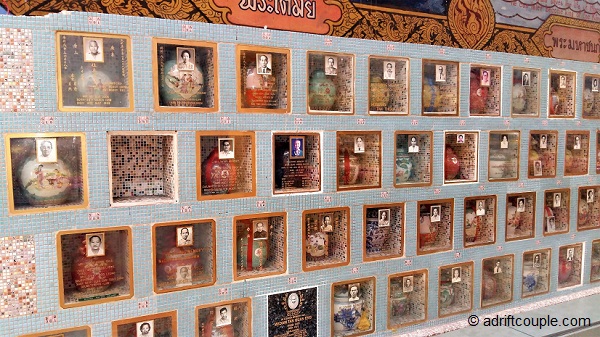
Travel introduces you at times to fanciful customs of different cultures. Here we were transfixed to see urns containing ashes of deceased people alongwith their pictures. This is an ancient tradition in Buddhist temples. Relatives of the deceased visit the temple for memorial services and conducting traditional rituals.
Dhammikarama – Burmese Buddhist Temple

Built in 1803, it is the oldest Burmese temple in Penang. With its lighter and subtle architecture it presented a serene and spacious environment. An interesting aspect of this temple is that it is also a ‘Kyaung’ which means a Burmese Buddhist Monastery.
We were enchanted by the gallery of wonderful paintings illustrating Siddharth’s early life and his journey as Gautama Buddha. Some of these which we photographed are depicted below.

Painting depicting birth of infant Siddhartha as a Bodhisattva prince who is pointing to the North and walked seven steps on lotuses.

Painting depicting royal marriage of prince Siddhartha and princess Yasodhara celebrated with great splendor at the Golden Palace.

The four great signs of the old, the sick, the dead and a serene mendicant monk, made prince Siddhartha ponder about the dissatisfaction in life and renunciation.
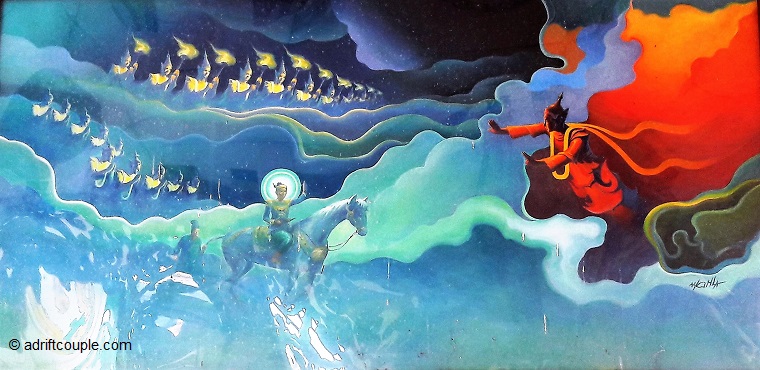
Prince Siddhartha going forth in his renunciation of the worldly life.

The Buddha preaching peace at a dispute over the water supply of the Rohini river by the two warring factions.

A beautiful lady, Cinca Manavika falsely accused The Buddha in the presence of monks and commoners, at an August assembly.
 Before visiting Penang, we hadn’t imagined that it would offer such a diverse experience and a tremendous mix of culture and history. As travellers, we often opinionate that one should visit a place with moderate expectations and an open mind. Having done so, we had a terrific stop-off at George Town and its suburbs.
Before visiting Penang, we hadn’t imagined that it would offer such a diverse experience and a tremendous mix of culture and history. As travellers, we often opinionate that one should visit a place with moderate expectations and an open mind. Having done so, we had a terrific stop-off at George Town and its suburbs.
Article Authored By: Achal Bindraban
Page Design By: Ranjana Achal

